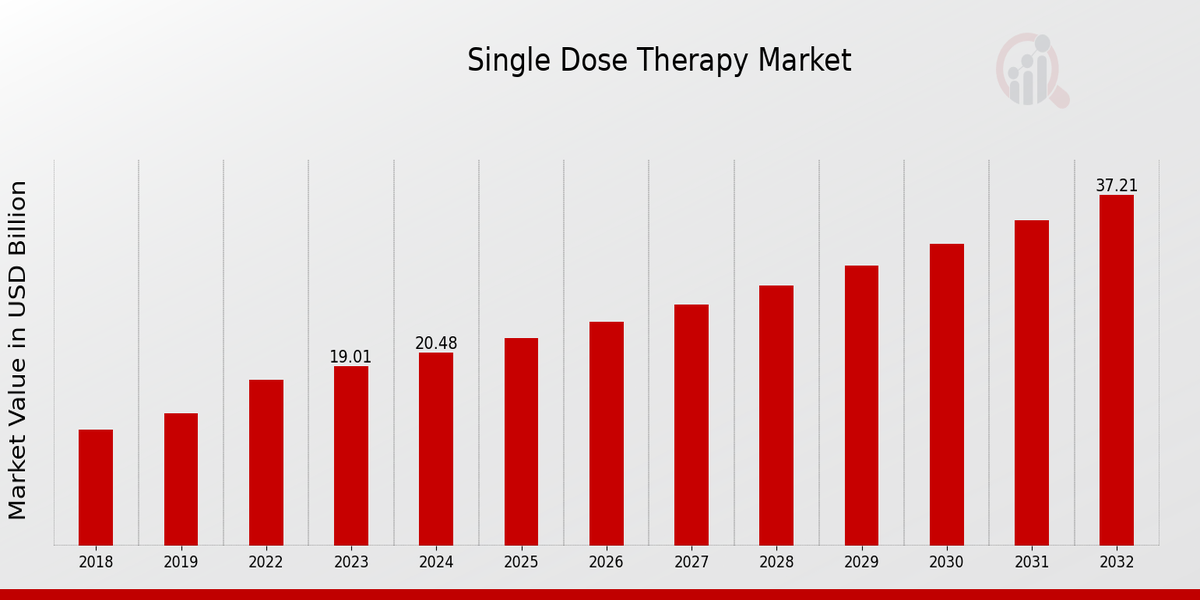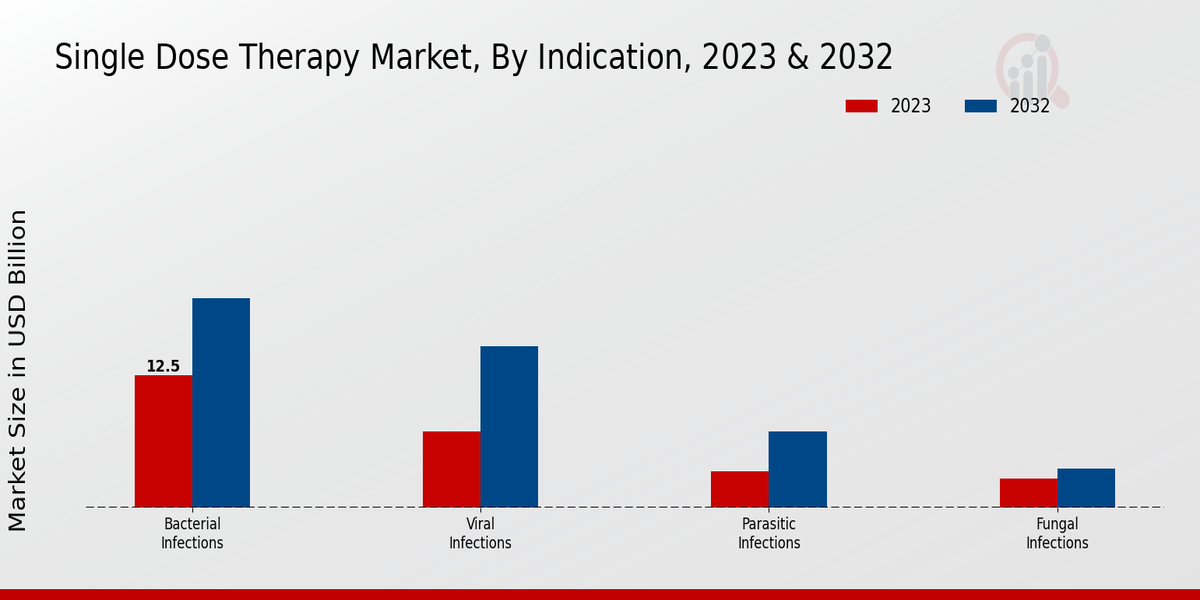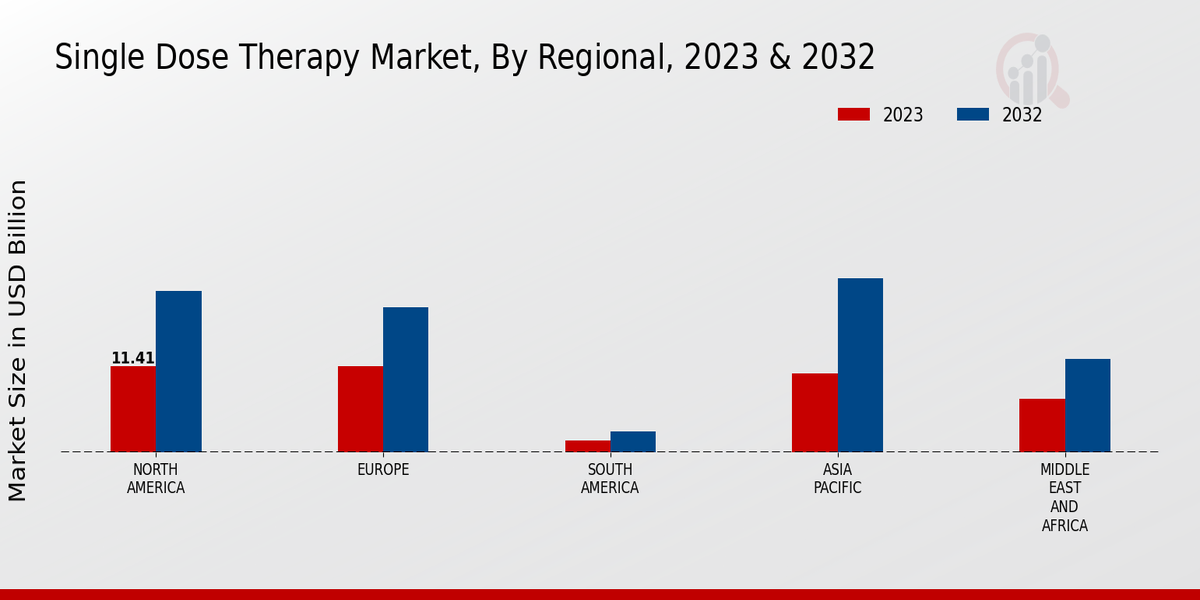Single Dose Therapy Market Overview
As per MRFR analysis, the Single Dose Therapy Market Size was estimated at 17.64 (USD Billion) in 2022. The Single Dose Therapy Market Industry is expected to grow from 19.01(USD Billion) in 2023 to 37.2 (USD Billion) by 2032. The Single Dose Therapy Market CAGR (growth rate) is expected to be around 7.75% during the forecast period (2024 - 2032).
Key Single-Dose Therapy Market Trends Highlighted
The main factors driving the worldwide single-dosage therapy market are improvements in drug delivery technology, rising chronic illness prevalence, increased awareness of single-dose medicines, and government support for precision medicine.
Profitable prospects for market expansion include entering emerging markets, creating novel single-dose formulations for complicated illnesses, and forming strategic alliances between pharmaceutical firms and academic institutions. Single-dose treatments that are customized for each patient's unique profile are becoming more and more popular. Targeted single-dose treatments with improved efficacy and fewer side effects are now possible because of developments in nanotechnology. AI algorithms are used to optimize single-dose regimens, predict therapeutic response, and analyze patient data.

Source Primary Research, Secondary Research, MRFR Database and Analyst Review
Single Dose Therapy Market Drivers
Increasing Prevalence of Chronic Diseases
One of the prominent market drivers of the single-dose therapy market is the increasing prevalence of chronic diseases such as cancer, cardiovascular diseases, and diabetes. These diseases require long-term treatment and single-dose therapies offer various advantages over traditional multiple-dose regimens due to their convenience and adherence advantages. For example, according to the World Health Organization, around 17.9 million deaths occurred in 2020 due to cardiovascular diseases, which makes this disease the leading cause of death.The increasing incidence of these chronic diseases is creating a growing need for effective and convenient treatments and, thereby, driving the single-dose therapy market. One of the motivations for the increasing demand for single-dose therapy is the advantages offered compared to traditional multiple-dose regimens. They improve the compliance of patients, reduce the risk of medication errors, and improve the efficacy of treatment. Moreover, single-dose therapies can also be more cost-effective than multiple-dose therapies due to the reduced need for multiple visits to healthcare providers and the risk of adverse drug events.As a result, they are becoming increasingly popular among healthcare professionals and patients. In the future, the single-dose therapy market is expected to be driven by an increasing number of chronic disease cases, increasing single-dose therapy usage, and technological advancements. Major players in the market are investing in research and development to produce innovative single-dose therapies for various diseases, and these factors will likely continue to support them in the future.
Technological Advancements and Innovation
The drivers of the Single Dose Therapy Market Industry are technological development and innovation. The advancement of new drug delivery systems, such as targeted drug delivery for nanotechnology, extended-release for controlled release and delayed release for controlled-release implant. Innovations have enabled the delivery of medicinal substances, such as drugs, in one dose. These innovations also increase the efficacy of the drug while reducing the side effects of the drug.An example is the development of a new nanocarrier by researchers at MIT in 2022 that can carry more than one drug and be programmed to release them at different times, increasing the efficacy of treatment for a variety of diseases.
Government Initiatives and Support
Government initiatives and support also facilitate the Growth of the Single Dose Therapy Market Industry. Governments across the world have recognized the benefits of single-dose therapies, and as such, they have started to formulate various policies and schemes to drive the growth of the single-dose therapy market. For instance, in 2021, the US Food and Drug Administration launched a new program to facilitate the development and approval of single-dose therapies for unmet medical needs.
Single Dose Therapy Market Segment Insights
Single Dose Therapy Market Indication Insights
The Single Dose Therapy Market is segmented by indication into bacterial infections, viral infections, parasitic infections, fungal infections, and other infections. Among these, bacterial infections held the largest market share in 2023 due to the high prevalence of bacterial infections worldwide. The Single Dose Therapy Market for bacterial infections is expected to reach USD 12.5 billion by 2032, growing at a CAGR of 7.5% during the forecast period. The increasing incidence of antibiotic resistance is a major factor driving the growth of this market.Viral infections are another major segment of the Single Dose Therapy Market. The Single Dose Therapy Market for viral infections is expected to reach USD 7.2 billion by 2032, growing at a CAGR of 8.2% during the forecast period. The increasing prevalence of viral infections, such as influenza and herpes, is driving the growth of this market. Parasitic infections are also a significant segment of the Single Dose Therapy Market. The Single Dose Therapy Market for parasitic infections is expected to reach USD 3.5 billion by 2032, growing at a CAGR of 7.8% during the forecast period.The increasing prevalence of parasitic infections, such as malaria and schistosomiasis, is driving the growth of this market. Fungal infections are a smaller segment of the Single Dose Therapy Market. The Single Dose Therapy Market for fungal infections is expected to reach USD 2.8 billion by 2032, growing at a CAGR of 7.3% during the forecast period. The increasing prevalence of fungal infections, such as candidiasis and aspergillosis, is driving the growth of this market. Other infections, such as sexually transmitted infections (STIs) and urinary tract infections (UTIs), also contribute to the Single Dose Therapy Market.The Single Dose Therapy Market for other infections is expected to reach USD 3.7 billion by 2032, growing at a CAGR of 8.1% during the forecast period. The increasing prevalence of infections, the rising demand for convenience, and the growing adoption of single-dose therapies are the major factors driving the growth of this market.

Source Primary Research, Secondary Research, MRFR Database and Analyst Review
Single Dose Therapy Market Route of Administration Insights
The Single Dose Therapy Market Segmentation by Route of Administration includes Oral, Parenteral, Topical, Inhalation, and Other Routes. Among these, the Oral route segment accounted for the largest revenue share in 2023 and is projected to maintain its dominance throughout the forecast period. The growth of this segment can be attributed to the ease of administration, patient convenience, and cost-effectiveness of oral medications. The Parenteral route segment is expected to witness a significant growth rate during the forecast period due to the increasing adoption of injectable therapies for chronic diseases.The Topical route segment is also anticipated to experience steady growth, driven by the rising prevalence of skin disorders and the development of innovative topical formulations. The Inhalation route segment is expected to show moderate growth, owing to the increasing use of inhaled therapies for respiratory diseases. The Other Routes segment includes transdermal, transmucosal, and sublingual routes, which are anticipated to contribute a small but growing share of the overall market.
Single Dose Therapy Market Mechanism of Action Insights
The Single Dose Therapy Market revenue from the Antibiotics segment is growing significantly and is expected to reach USD 7.8 billion by 2024. The growth of this segment can be attributed to the increasing prevalence of bacterial infections and the rising demand for effective and convenient treatment options. The Antivirals segment is also expected to witness steady growth, owing to the rising prevalence of viral infections such as influenza and herpes. The Antifungals segment is expected to grow at a moderate pace, driven by the increasing incidence of fungal infections and the development of new antifungal agents.The Antiparasitics segment is expected to grow slowly due to the decreasing prevalence of parasitic infections and the availability of effective treatment options. Other Mechanisms segment is expected to witness a modest growth, driven by the development of new drugs and the increasing demand for targeted therapies.
Single Dose Therapy Market Patient Population Insights
The Single Dose Therapy Market segmentation by Patient Population includes Adult, Pediatric, Geriatric, and Other Patient Populations. Among these segments, the Adult segment held the largest market share in 2023, accounting for over 60% of the market revenue. The high prevalence of chronic diseases and the increasing adoption of single-dose therapies for various indications in the adult population are key factors driving the growth of this segment. The Pediatric segment is also expected to witness significant growth, with a CAGR of over 8% during the forecast period.The increasing focus on developing single-dose therapies for pediatric patients, particularly in the areas of infectious diseases and vaccinations, is contributing to the growth of this segment. The Geriatric segment is another important market segment, as the elderly population is more susceptible to chronic diseases and requires effective and convenient treatment options. The Other Patient Populations segment includes niche patient populations such as pregnant women, immunocompromised individuals, and patients with rare diseases and is expected to contribute a moderate share to the overall market revenue.
Single Dose Therapy Market Regional Insights
The Single Dose Therapy Market is segmented into North America, Europe, APAC, South America, and MEA. North America held the largest market share in 2023 and is expected to continue to dominate the market throughout the forecast period. The growth of the market in North America can be attributed to the increasing prevalence of chronic diseases and the growing adoption of single-dose therapies. Europe is the second-largest market for single-dose therapy and is expected to grow at a steady pace over the forecast period. The growth of the market in Europe can be attributed to the increasing awareness of single-dose therapies and the growing adoption of these therapies in various therapeutic areas.APAC is expected to be the fastest-growing market for single-dose therapy over the forecast period. The growth of the market in APAC can be attributed to the increasing population and the growing prevalence of chronic diseases. South America and MEA are expected to grow at a moderate pace over the forecast period. The growth of the market in these regions can be attributed to the increasing awareness of single-dose therapies and the growing adoption of these therapies in various therapeutic areas.

Source Primary Research, Secondary Research, MRFR Database and Analyst Review
Single Dose Therapy Market Key Players And Competitive Insights
Key companies operating in the Single Dose Therapy Market are invariably involved in R to develop novel products and aggressively expand their market shares. Leading stakeholders operating in the Single Dose Therapy Market are resorting to collaboration, partnership, and acquisition to maintain their market dominance and gain superior technology for establishing a strong foothold in an emerging market. With the emergence of versatile technologies that enable accessible treatment distribution, the Single Dose Therapy Market can be characterized by competitive collaboration between established stakeholders and emergent innovators. Some of the most prominent drivers for industry growth are expected to be an increasingly prevalent chronic disease, in combination with the heightened demand for convenient and effective drugs, coupled with the superior technological features of application-specific drug delivery.
Pfizer Inc. is one of the most prominent companies operating in the Single Dose Therapy Market, which features some of the most outstanding single-dose therapies in a broad spectrum of medical applications, ranging from vaccines to anti-infectives and oncology. The company's reach and constant efforts for innovation ensure that Pfizer remains a leading player firmly established in the market, boasting some of the most extensive pharmacy and hospital distribution networks with the highest brand value in the industry among its other core strengths. The company's pipeline includes some of the most promising solutions for the Single Dose Therapy Market. One of the most notable competitors, Merck Co., Inc., is also involved in the Single Dose Therapy Market, boasting single-dose therapy solutions for a broad spectrum of conditions, including vaccines, antivirals, and immuno-oncology. Some of the most significant solutions developed by this company have been developed as part of the rigorous R initiatives. Merck Co. currently has one of the most extensive market penetration for the development of partnerships.
Key Companies in the Single Dose Therapy Market Include
- Astellas Pharma Inc.,
- Takeda Pharmaceutical Company Limited
- AbbVie Inc.,
- Regeneron Pharmaceuticals,
- Merck KGaA,
- AstraZeneca PLC,
- Johnson Johnson,
- Eli Lilly and Company,
- Bristol Myers Squibb,
- Novo Nordisk,
- Sanofi,
- Pfizer Inc.,
- Alexion Pharmaceuticals Inc.,
- Novartis AG,
Single Dose Therapy Market Industry Developments
The Single Dose Therapy Market is anticipated to grow significantly in the coming years, driven by the increasing prevalence of chronic diseases and rising demand for patient convenience. In 2023, the market was valued at USD 19.01 billion, and it is projected to reach USD 37.2 billion by 2032, exhibiting a CAGR of 7.75%.Recent developments in the market include the launch of new single-dose therapies for various indications such as cancer, infectious diseases, and autoimmune disorders. Key players are focusing on developing innovative drug delivery systems to enhance efficacy and reduce side effects. Strategic collaborations and acquisitions are also shaping the competitive landscape of the market.The rising adoption of single-dose therapies in emerging markets, coupled with favorable reimbursement policies, is expected to drive growth in the coming years. However, factors such as patent expirations and pricing pressures may pose challenges to market growth.
Single Dose Therapy Market Segmentation Insights
-
Single Dose Therapy Market Indication Outlook
- Bacterial Infections
- Viral Infections
- Parasitic Infections
- Fungal Infections
- Other Infections
-
Single Dose Therapy Market Route of Administration Outlook
- Oral
- Parenteral
- Topical
- Inhalation
- Other Routes
-
Single Dose Therapy Market Mechanism of Action Outlook
- Antibiotics
- Antivirals
- Antifungals
- Antiparasitics
- Other Mechanisms
-
Single Dose Therapy Market Patient Population Outlook
- Adult
- Pediatric
- Geriatric
- Other Patient Populations
-
Single Dose Therapy Market Regional Outlook
- North America
- Europe
- South America
- Asia-Pacific
- Middle East and Africa
| Report Attribute/Metric |
Details |
| Market Size 2022 |
17.64(USD Billion) |
| Market Size 2023 |
19.01(USD Billion) |
| Market Size 2032 |
37.2(USD Billion) |
| Compound Annual Growth Rate (CAGR) |
7.75% (2024 - 2032) |
| Report Coverage |
Revenue Forecast, Competitive Landscape, Growth Factors, and Trends |
| Base Year |
2023 |
| Market Forecast Period |
2024 - 2032 |
| Historical Data |
2019 - 2022 |
| Market Forecast Units |
USD Billion |
| Key Companies Profiled |
Astellas Pharma Inc.,, Takeda Pharmaceutical Company Limited, AbbVie Inc.,, Regeneron Pharmaceuticals,, Merck KGaA,, AstraZeneca PLC,, Johnson Johnson,, Eli Lilly and Company,, Bristol Myers Squibb,, Novo Nordisk,, Sanofi,, Pfizer Inc.,, Alexion Pharmaceuticals Inc.,, Novartis AG, |
| Segments Covered |
Indication, Route of Administration, Mechanism of Action, Patient Population, Regional |
| Key Market Opportunities |
Expanding treatment options Growing geriatric population Technological advancements Tailored therapies Rising prevalence of chronic diseases |
| Key Market Dynamics |
Rising prevalence of chronic diseases Technological advancements Growing focus on patient convenience Increasing government initiatives Expanding healthcare infrastructure |
| Countries Covered |
North America, Europe, APAC, South America, MEA |
Frequently Asked Questions (FAQ) :
The Single Dose Therapy Market is projected to reach an overall valuation of 37.2 billion USD by 2032.
The Single Dose Therapy Market is anticipated to register a CAGR of 7.75% during the forecast period of 2024-2032.
The growing prevalence of chronic diseases and the increasing demand for convenient and effective treatments are major factors driving the growth of the Single Dose Therapy Market.
Key players in the Single Dose Therapy Market include Merck Co., Inc., Novartis AG, Pfizer Inc., and Sanofi S.A., among others.
The oncology segment is projected to account for the largest share of the Single Dose Therapy Market by 2032, owing to the rising incidence of cancer worldwide.
Challenges in the Single Dose Therapy Market include the high cost of development and manufacturing, reimbursement issues, and the emergence of biosimilars.
The Single Dose Therapy Market is segmented based on type, application, and region.
Emerging markets are expected to offer significant growth opportunities for the Single Dose Therapy Market due to a growing population, increasing healthcare spending, and a rising burden of chronic diseases.
Key trends shaping the future of the Single Dose Therapy Market include the development of novel therapies, personalized medicine, and the adoption of value-based healthcare models.

















